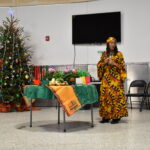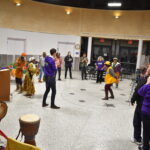Residents of Marine Park gathered at the Carmine Carro Community Center on Saturday afternoon, December 14th, to observe a pre-celebration of the upcoming holiday, Kwanzaa.
Organized by the Marine Park Alliance, with the support of other organizations and Brooklyn College’s assistant professor, Dr. Simanique Moody, who taught attendees the origins and meaning of Kwanzaa.
Beginning on December 26th and ending on January 1st, Kwanzaa celebrates aspects of African-American and African cultures and promotes the values of community, hope and unity, the latter of which was a significant part of the event.
The ceremony began with a musical program performed by Arleen Griffith, Brother Mac and Baba Raheem. The three played shakers, yangban and djembe (African drums).
Councilwoman Mercedes Narcisse of District 46 was in attendance and announced her support for the MPA, the Kwanzaa celebration, and the community overall, and stressed the importance of unity during these times.
“The more you understand each other, you see how close you are. The more you spend time and understand what the person stands for, the easier it gets to work together,” she said. “So, I am so grateful to be part of such an amazing club.”
Moody did a libation custom as she poured water into a plant and repeated the name of an elder who had passed, as the attendees called out their names. She then explained the history of Kwanzaa and its significance today.
Maulana Karenga, an African-American activist, created the holiday in 1966, basing it on Pan-African values as well as African-American culture and how everyone in the community, regardless of race, can follow those values.
Afterward, Griffith conducted a dance workshop after the African dance, funga, a dance of hospitality, followed by everyone singing the hymn, “Lift Every Voice and Sing.”
“The people are welcoming and very friendly, and it’s a wonderful, festive atmosphere. We appreciate having had the opportunity to serve the community,” said Griffith. “I think the dancing made it even more lively. The music invigorates and no one can resist the drums, so we all dance enjoyment together.”
Near the end of the ceremony, Moody invited volunteers from the audience to light the candles in the kinara, which in Swahili means “candle holder.” The lighting begins with the black candle in the center and then moves from left to right. The color of the candles all represent something—black represents the African people, red represents the struggle of the African people and green represents future hope.
As there are seven candles in the kinara, there are the Nguzo Saba (seven principles) to Kwanzaa, which are — Umoja (unity), Kujichagulia (self-determination), Ulima (collective work), Ujamaa (cooperative economics), Nia (purpose), Kuumba (creativity) and Imani— (faith).
As the event concluded, there was one more dance in which everyone in the center participated and expressed the principle of unity and joy.
“I was thrilled by the outpouring of community support, particularly seeing people of all ages and cultural backgrounds come together to learn about the history of Kwanzaa,” said Moody. “The drumming provided by the Healing Drums Community ensemble truly created an atmosphere of Umoja, which is the first of the Nguzo Saba of Kwanzaa. I felt great pride and joy at seeing how enthusiastically the audience members participated in tonight’s pre-Kwanzaa celebration, from dancing and singing to reciting the Nguzo Saba during the candlelighting ceremony.”








Almost all of the things you say happens to be astonishingly precise and it makes me ponder why I had not looked at this in this light before. This particular article really did switch the light on for me personally as far as this particular topic goes. Nevertheless at this time there is one particular issue I am not really too comfy with and while I attempt to reconcile that with the core theme of the issue, let me observe exactly what all the rest of the visitors have to point out.Nicely done.